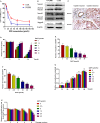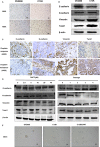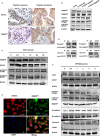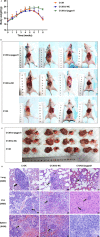Role of Jagged1/STAT3 signalling in platinum-resistant ovarian cancer
- PMID: 30993885
- PMCID: PMC6533470
- DOI: 10.1111/jcmm.14286
Role of Jagged1/STAT3 signalling in platinum-resistant ovarian cancer
Abstract
Jagged1, the essential ligand of the Notch signalling pathway, is highly expressed in metastatic prostate cancer, and its high expression in breast cancer is linked to poor survival rates. However, the mechanism of Jagged1's involvement in platinum-resistant ovarian cancer has not been thoroughly elucidated to date. The purpose of the present study was to investigate the roles of Jagged1 in the platinum resistance of ovarian cancer and its possible mechanisms. Compared with a platinum responsive group of ovarian epithelial cell carcinomas, we found the positive staining intensity of Notch1, Notch2, Jagged1, STAT3 and Epithelial-mesenchymal transition (EMT) proteins were lower in a platinum-resistant group. The DDP-resistant ovarian cancer cell line (C13K) had a higher IC50 of DDP than its parental cell line (OV2008) (P < 0.05) and acquired an EMT phenotype and invasive characteristics. Inhibiting or knockdown of Jagged1 expression could not only reduce its capacity of migration and invasion but also reverse EMT and down-regulate the expression of serine 727-phosphorylated STAT3 (pS727) at the protein level but not total STAT3 or tyrosine 705-phosphorylated STAT3 (pY705) in C13K cells. Furthermore, it was found that crosstalk between the Jagged1/Notch and JAK/STAT3 signalling pathways were involved in Jagged1-promoting EMT in C13K cells. Experiments in vivo showed a reduced micrometastatic tumour burden in the lung, liver and spleen of mice implanted with C13K cells with knocked-down Jagged1 compared with mice implanted with control cells. All of these results demonstrate that Jagged1 can crosstalk with the JAK/STAT3 pathway, and they all cooperate to promote the aberrant occurrence of EMT, further reinforcing the abilities of invasion and migration of platinum-resistant ovarian cancer in vivo and in vitro.
Keywords: Jagged1; STAT3; crosstalk; ovarian cancer; platinum resistance.
© 2019 The Authors. Journal of Cellular and Molecular Medicine published by John Wiley & Sons Ltd and Foundation for Cellular and Molecular Medicine.
Conflict of interest statement
The authors have declared that there is no conflict of interest.
Figures





Similar articles
-
NANOG regulates epithelial-mesenchymal transition and chemoresistance through activation of the STAT3 pathway in epithelial ovarian cancer.Tumour Biol. 2016 Jul;37(7):9671-80. doi: 10.1007/s13277-016-4848-x. Epub 2016 Jan 22. Tumour Biol. 2016. PMID: 26801672
-
MicroRNA-302 represses epithelial-mesenchymal transition and cisplatin resistance by regulating ATAD2 in ovarian carcinoma.Exp Cell Res. 2020 Nov 1;396(1):112241. doi: 10.1016/j.yexcr.2020.112241. Epub 2020 Aug 21. Exp Cell Res. 2020. PMID: 32835657
-
SMAD3 inducing the transcription of STYK1 to promote the EMT process and improve the tolerance of ovarian carcinoma cells to paclitaxel.J Cell Biochem. 2019 Jun;120(6):10796-10811. doi: 10.1002/jcb.28371. Epub 2019 Jan 30. J Cell Biochem. 2019. PMID: 30701575
-
Role of Extracellular Vesicles in Epithelial Ovarian Cancer: A Systematic Review.Int J Mol Sci. 2020 Nov 19;21(22):8762. doi: 10.3390/ijms21228762. Int J Mol Sci. 2020. PMID: 33228245 Free PMC article.
-
Ovarian Cancer-Insights into Platinum Resistance and Overcoming It.Medicina (Kaunas). 2023 Mar 10;59(3):544. doi: 10.3390/medicina59030544. Medicina (Kaunas). 2023. PMID: 36984544 Free PMC article. Review.
Cited by
-
Conservation of Epithelial-to-Mesenchymal Transition Process in Neural Crest Cells and Metastatic Cancer.Cells Tissues Organs. 2021;210(3):151-172. doi: 10.1159/000516466. Epub 2021 Jul 2. Cells Tissues Organs. 2021. PMID: 34218225 Free PMC article.
-
Jagged1 intracellular domain/SMAD3 complex transcriptionally regulates TWIST1 to drive glioma invasion.Cell Death Dis. 2023 Dec 13;14(12):822. doi: 10.1038/s41419-023-06356-0. Cell Death Dis. 2023. PMID: 38092725 Free PMC article.
-
Biomedical engineering approaches for the delivery of JAGGED1 as a potential tissue regenerative therapy.Front Bioeng Biotechnol. 2023 Sep 11;11:1217211. doi: 10.3389/fbioe.2023.1217211. eCollection 2023. Front Bioeng Biotechnol. 2023. PMID: 37781534 Free PMC article. Review.
-
JAG1, Regulated by microRNA-424-3p, Involved in Tumorigenesis and Epithelial-Mesenchymal Transition of High Proliferative Potential-Pituitary Adenomas.Front Oncol. 2020 Dec 23;10:567021. doi: 10.3389/fonc.2020.567021. eCollection 2020. Front Oncol. 2020. PMID: 33425722 Free PMC article.
-
Blocking Notch signal pathway suppresses the activation of neurotoxic A1 astrocytes after spinal cord injury.Cell Cycle. 2019 Nov;18(21):3010-3029. doi: 10.1080/15384101.2019.1667189. Epub 2019 Sep 18. Cell Cycle. 2019. PMID: 31530090 Free PMC article.
References
-
- Christiansen JJ, Rajasekaran AK. Reassessing epithelial to mesenchymal transition as a prerequisite for carcinoma invasion and metastasis. Cancer Res. 2006;66(17):8319‐8326. - PubMed
-
- Nieto MA, Huang RY, Jackson RA, et al. EMT: 2016. Cell. 2016;166(1):21‐45. - PubMed
-
- Thiery JP. Epithelial‐mesenchymal transitions in tumour progression. Nat Rev Cancer. 2002;2(6):442‐454. - PubMed
-
- Thiery JP, Lim CT. Tumor dissemination: an EMT affair. Cancer Cell. 2013;23(3):272‐273. - PubMed
Publication types
MeSH terms
Substances
LinkOut - more resources
Full Text Sources
Medical
Molecular Biology Databases
Miscellaneous

